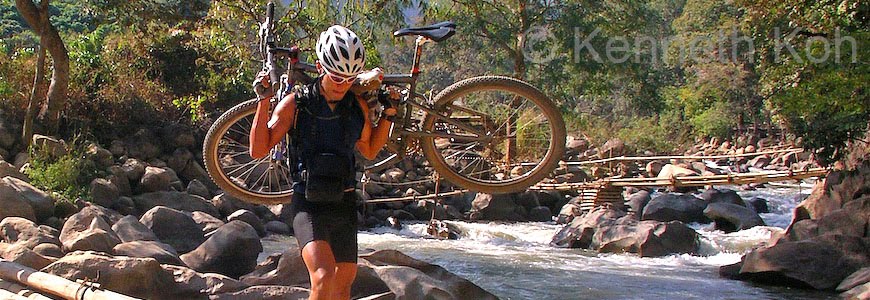 The Perfect Ride. Canon XT/350D, 10-22mm, 1/60 f/5, ISO400.
The Perfect Ride. Canon XT/350D, 10-22mm, 1/60 f/5, ISO400.We’ve all made mistakes with our 1st mountain bike, perhaps buying a cheap, heavy, klunker that didn’t fit right. Now you’re ready for your next bike and are determined not to repeat the mistakes of the past. While you may have bought your first bike as a complete bike set from the showroom, your next bike is likely to built up, ie. buying the frame, wheels and other components separately. This gives your bike a more personal feel and you end up only paying for what you really want on the bike.
Do your research
There is more to building a frame than welding a bunch of metal tubes together. Full suspension or hardtail? Aluminum vs. Titanium vs. Carbon vs. Steel? V-brakes or Discs? It comes down to personal preference, riding style, riding conditions, and sometimes even marketing hype. Websites like www.Mtbr.com have a wealth of information and reviews.
What I ride: The 2006 Santa Cruz Superlight. Single-pivot full suspension aluminum bike with V-brakes. I travel with my bike and I need something light and simple.
 Going places with my bike. Hoisting my Santa Cruz Superlight across a bamboo bridge in Northern Thailand. Taken by Laura Liong with my Pentax Optio 43WR, 1/160 f/6.9, ISO 64.
Going places with my bike. Hoisting my Santa Cruz Superlight across a bamboo bridge in Northern Thailand. Taken by Laura Liong with my Pentax Optio 43WR, 1/160 f/6.9, ISO 64.Don’t buy cheap components
Go Shimano XT or XTR if you can afford it. Upgrade lesser parts to at least Shimano XT, particularly the rear derailleur and cassette. LX is ok, but XT components are much more durable and are much more pleasant to use than lesser components like (shudder) Alivio. The cheap cassette on my first bike wore out after three months. The cheap headset on my 2nd bike needed to be changed after just 2 weeks. By comparison, most of my Shimano XTR parts have been with me since 2002. Sure, parts do wear out over time, but good components last much longer and will pay for themselves over the long run. You'll also get a more positive riding experience.
What I use: Shimano XTR except for SRAM X0 twist shifters and rear derailleur.
Get Fit
A proper bike fit is more than straddling the bike and checking the clearance between your crotch and the top tube. It is best if your bike shop can do a proper fit, otherwise websites like www.competitivecyclist.com have a mountain bike fit calculator that uses a few simple body measurements like your inseam, torso, forearm length, and give you output such as what standover height, top tube length, stem length you need. It’s free and it takes about 20 minutes. It is well worth the time and effort. You may find out that your dream bike manufacturer may not make a frame in your size. For example, I liked the Specialized brand, but they didn't make a frame that would fit my long torso/short legs body. They made a 15.5" frame that was too cramped for me and a 17" that didn't have sufficient standover clearance. I had to look elsewhere.
Ride it
Finally, there’s nothing like riding the bike you want to buy. Ideally, your buddy is your size and has your dream ride that you can borrow, otherwise your bike shop should let you take a quick spin around the parking lot. Sometimes, a quick ride is enough to reveal that your dream ride isn't it all what you thought it was going to be.
Updated: 26 Oct 08 (expansion and clarification).


.jpg)


